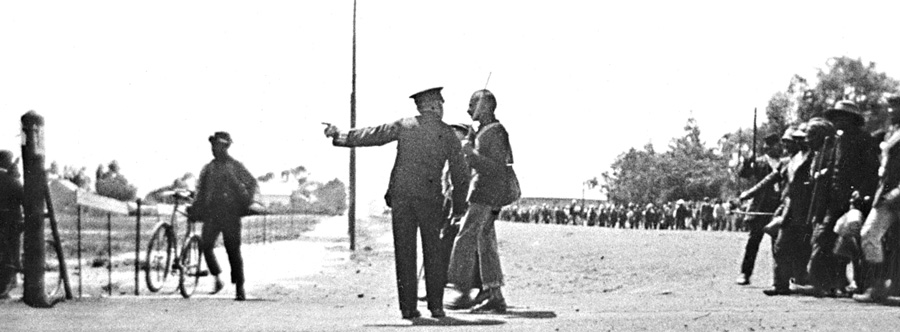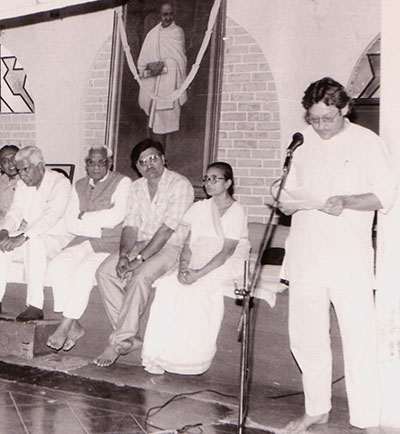
Introduction
The Gandhi Collection is likely the most comprehensive private collection of photographs, films, and audio recordings of Mohandas Karamchand Gandhi. This collection, comprising approximately 4600 prints, negatives, contact print bundles, 8 and 16mm films, commercially produced postcards, and other reproductions, represents a unique documentary record of one of the twentieth century's most pivotal figures. Numerous individual images within this collection capture facets of Gandhi's remarkable character, charting the course of his life—a journey that profoundly influenced the history of his nation and offered the world a powerful example of nonviolent revolutionary change.
The collection features images of Gandhi as a child, a young lawyer in Western attire, and as the leader of Satyagraha in South Africa. However, the majority of the photographs show him in India, donning round spectacles and a dhoti. It includes films of him spinning the charkha, which he viewed as a path to swadeshi, and captures moments with his friends, family, and followers in the modest setting of his ashram. His keen eyes are evident as he engages in discussions with British officials and Indian nationalists, and as he addresses vast gatherings at rallies and public events. Gandhi's own words, “my life is my message,” resonate through this collection, offering a unique and profound glimpse into his life.

how the collection came about
"Search-n-Research" has been the theme of a 30-year ongoing project dedicated to the systematic collection of oral histories and the discovery of previously unknown materials related to Mahatma Gandhi. Peter Ruehe, the founder of GandhiServe, has met with many of Gandhi's associates, relatives, photographers, collectors, and contemporaries across India and beyond. He has documented memories and firsthand accounts of Gandhi and the Indian independence movement, contributing to the preservation of valuable films, letters, photographs, and documents.
Peter Ruehe assembled the collection starting in the mid-1980s, inspired by his extensive travels in India tracing Mahatma Gandhi's path. He obtained the materials in various phases from the heirs of Kanu Gandhi and Jhaveri, after significant collaboration on organizing, preserving, and managing the copyrights of their collections. The items were transported from India to Germany upon acquisition, from 1988 to 1994, and have since been utilized by Peter Ruehe and GandhiServe to further Gandhi's legacy.

in peter ruehe's own words
Since 1983, I have been traveling frequently to India to visit individuals and sites associated with Mahatma Gandhi and the Indian independence movement.
The late Vithalbhai K. Jhaveri (1916-1985), a Mumbai-based biographer of Gandhi, possessed the most extensive collection of over 9,000 photographs documenting Mahatma Gandhi and India's independence movement. A member of the Indian National Movement, Jhaveri significantly contributed to promoting Gandhian philosophy and preserving the memory of India's unique nonviolent independence struggle. He dedicated his life to gathering photographs, films, and footage of Gandhi from global sources. Jhaveri, who became one of Gandhi's most distinguished biographers, used his collection solely for his exhibitions, films, and publications, with the majority of images remaining unseen by the public, not available for research, publication, or personal use. Following Jhaveri's death, I visited his Mumbai estate and discovered the photographs in a large wooden trunk on a terrace by the sea. The high humidity in Mumbai had damaged some photographs irreparably. Jhaveri's family consented to preserve the surviving photographs and catalog them scientifically. When no Indian institution stepped forward to undertake this task, the photographs were sent to me in Germany. Over five years, I cleaned them, organized them chronologically, meticulously developed captions, prepared repro negatives and prints, and stored the entire collection in an archival environment with pergamin bags, acid-free paper, and plastic covers free of softeners. In return, I was allowed to select approximately 1,000 surplus photo prints.
Kanu Gandhi's collection, the second largest anthology of Mahatma Gandhi's photographs after Jhaveri's, holds the distinction of being the largest from a single photographer. Kanu Gandhi (1917-1986), Gandhi's great-nephew, resided with his family in Gandhi's ashrams in Ahmedabad and near Wardha in central India. As a member of Gandhi's personal staff, Kanu worked closely with him until his assassination on January 30, 1948. His journey as a photographer began in 1936 when he received his first camera and a roll of film, marking the start of his documentation of the last decade of Gandhi's life. Gandhi permitted Kanu to photograph him under three conditions: no flash photography, no financial burden on the ashram, and no posing. As the sole individual granted unrestricted access to photograph his granduncle, Kanu captured Mahatma Gandhi in various moods and moments. His photographs offer a glimpse into the private life of Gandhi, contrasting with his public persona as the Mahatma. In 1985, I had the privilege of meeting Kanu Gandhi at his Rajkot home in Gujarat, where he proudly shared his invaluable photographs with me.
Following Kanu Gandhi's death, I visited his widow Abha, known as one of Gandhi's 'living walking sticks' and the person in whose arms he passed away. During Kanu's lifetime, his photo lab was off-limits. Now, it required clearing. Abha intended to discard the thousands of photographs, mostly of Gandhi, cluttering the space. She felt no need for them, having lived with Gandhi and possessing an album of her late husband's main collection. I persuaded her to preserve these items, arguing their immense value for others seeking an authentic view of the Mahatma. Consequently, Abha Gandhi sold and gifted me a significant portion of the surplus photographs, films, and negatives as I helped her caption her late husband's collection posthumously.
Further information: Peter Ruehe's autobiography Gandhi and I and his lecture Anecdotes from Mahatma Gandhi's Inner Circle
collection overview
The collection consists of two primary subcollections, each with its own unique history and emphasis. The first subcollection originates from the studio of photographer Kanu Gandhi and includes over 3600 prints with more than 1000 photographic images of Mahatma Gandhi, alongside a variety of related images, postcards, and other commercial reproductions. The second subcollection comes from the estate of writer and filmmaker Vithalbhai Jhaveri, containing nearly 1000 prints and about 500 distinct images. Additionally, the Gandhi Collection encompasses a selection of items from various other sources and an extensive array of contemporary materials, including VHS videos, CDs, DVDs, reproduction negatives, modern prints, records, and audio cassettes.

100 Audio cassettes on Mahatma Gandhi, India and India's independence movement
135 Audio CDs on Mahatma Gandhi
17 Records on Mahatma Gandhi
19553 Repro-negatives of Mahatma Gandhi (24 x 36 mm)
16356 Modern photographs of Mahatma Gandhi (developed between 1980 and today)
5031 Old photographs of Mahatma Gandhi (developed in the 1950s to 70s)
2000 Slides of Mahatma Gandhi (24 x 36 mm)
595 Vintage photographs of Mahatma Gandhi (developed within five years after the photograph was taken)
100 Glas positives (transparencies; 8 x 8 cm) of Mahatma Gandhi
2 Photo exhibitions MAHATMA - Images of M. K. Gandhi (50 prints of 25 x 38 cm)
2 Photo exhibitions Мahatma Gandhi's Peace March through Bihar - A Photographer's Account (50 prints of 25 x 38 cm)
Photo exhibition Mahatma Gandhi - Travelling by Train (50 prints of 25 x 38 cm)
390 Books on Mahatma Gandhi
30 Books on India
7 Old newspapers and magazines (vintage)
1 Palm leaf letter to Mahatma Gandhi in Mallayalam
1 Box file with the Reginald Reynolds and Louis Fischer Archive
229 VHS-video tapes containing films, footage and TV reports about Mahatma Gandhi and India's independence movement
252 DVDs/VCDs on Mahatma Gandhi
278 DVDs/VCDs on India
3 Original 8mm films of Mahatma Gandhi
2 Original 16mm films about Vinoba Bhave
1 Orig. 16mm film about Mahatma Gandhi's post-cremation
1 Orig. 16mm film of a dance performance at an ashram
1 Original 16mm film of miscellaneous content
2958 Old postcards and photo prints of Mahatma Gandhi
3000 Stamps of Mahatma Gandhi from c. 120 countries
600 Childrens paintings (20 x 30 cm to 40 x 60 cm) of drawing competition Мahatma Gandhi As I see Him
70 Jigsaw puzzles Мy Life is My Message (130 pieces, 28 x 43 cm)
26 Box files with addresses, photos and information about Gandhi institutions in India and abroad
20 T-shirts Мy Life is My Message (black, white)
13 Oil paintings of Mahatma Gandhi, Nelson Mandela, Dr. Martin Luther King, Jr., HH the Dalai Lama and Peace
1 Sandpainting portrait of Mahatma Gandhi 48 x 62 cm
glimpses of the collection
In 2022, approximately 90% of the collection was acquired by the Museum of Art and Photography in Bengaluru.
In the following shipping inventory list those items are marked "B" and "C".











